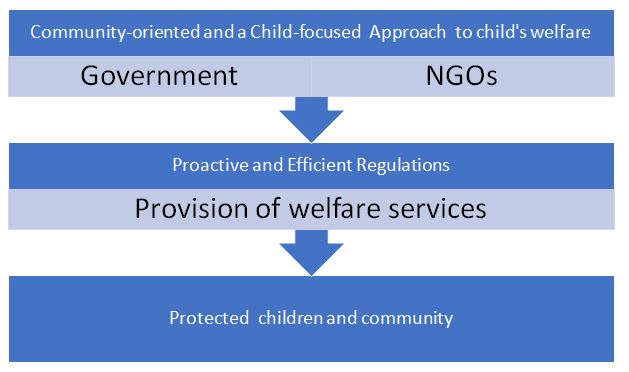Children form a significant part of the population of any given country (Dubowitz & DePanfilis, 2000). Due to the risk factors exposed to children, it is necessary for the community to ensure that they protect the rights and wellbeing of children. However, since past regulations do not apply in the current setting, the adoption of a community-oriented and child-focused approach to child welfare seems to be a suitable solution to this issue.
Such is attributable to the fact that such a strategy would lead to regulations that are more proactive and efficient. However, this approach is likely to have a number of challenges. For this reason, this paper will look into some of the disadvantages of its adoption, along with possible solutions to the drawbacks.
First, it is hard for children’s rights protection institutions to establish the history of all families and thus provides general solutions. Usually, the agencies and other organizations that have the mandate to protect the welfare of children need to analyze the family backgrounds of concerned children (Kodish, 2005). Such is necessary in order to validate any possible disorder effects that would lead to cases of abuse. Some of the disorders include parent neglect and social stigma.
Research establishes that few people are likely to give their family backgrounds, intentionally or otherwise (Dubowitz & DePanfilis, 2000). Due to such scenarios, the community-oriented and child-focused approach might not work effectively. However, the concerned institutions can overcome this challenge through the establishment of projects that ensure families interact with one another freely. As such, it becomes easy to solicit information about a given family from neighbors.
Secondly, the approach relies on nongovernmental institutions for implementation. There has been a shared belief that NGOs ought to address issues touching on the welfare of children and that of the community (Kodish, 2005). For this reason, most of the tasks are unattended with the thought that it is the responsibility of NGOs. Such scenarios have always led to deficits among many NGOs, making issues such as children’s rights.
As such, a need is inevitable for the government in collaboration with other agencies ought to establish a partnership to set ought a roadmap that ensures accommodative environments on child welfare protection. Such a situation is achievable through the extension of duties that child welfare institutions have (Kodish, 2005). This initiative thus should take into consideration appropriate service charter, as well as logical support aimed at addressing the deficits that nongovernmental organizations have been experiencing.
Conclusion
From above, it suffices that for the welfare of children to be adequately addressed, implementation of proactive regulations is inevitable. For this reason, a community-oriented and child-focused approach is a suitable option. Such is attributable to its ability to address current needs that face children within a given community.
In addition, such an approach considers the pursuit of action-based and bold solutions to child welfare (Lawrence, 2004). Further, a community-oriented and a child-focused approach to rights will lead to regulations based on the needs of community efficient and proactive laws that result in the ultimate protection of children.

On the other hand, the proposed approach is likely to be affected by factors such as overreliance on NGOs for service delivery as well as difficulties in accessing information on family backgrounds for validation purposes. However, adopting strategies aimed at ensuring that families intermingle would help to gather any necessary information when need be.
In addition, the community-oriented and child-focused approach can be successful if government partnerships, along with welfare protection institutions, join NGOs in the fight for better child welfare. Evidently, a community-oriented and child-focused approach is a suitable solution to the problem.
References List
Dubowitz, H., & DePanfilis, D. (2000). Handbook for child protection practice. Thousand Oaks: Sage Publications.
Kodish, E. (2005). Ethics and research with children. Oxford: Oxford University Press.
Lawrence, A. (2004). Principles of child protection. Maidenhead: Open University Press.